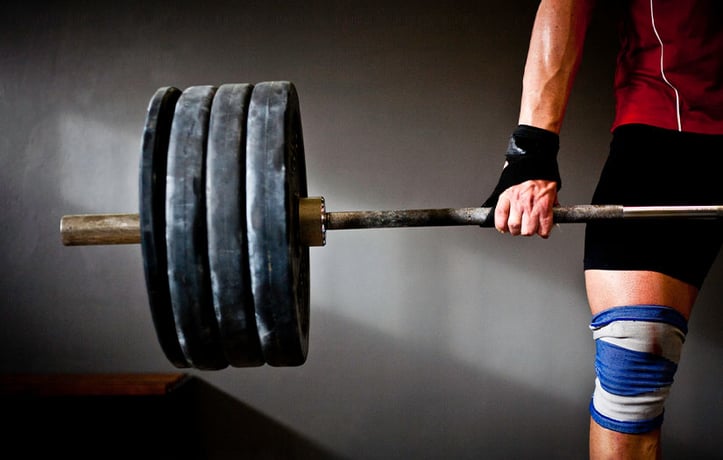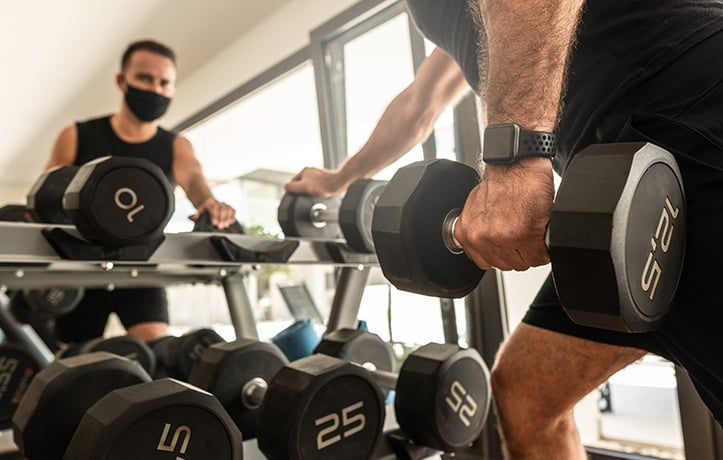In case you missed it,在本系列的第2部分中, we discussed how to get better at push-ups once you have already nailed form down.
本文(第3部分Stabilization Endurance Training。
俯卧撑说
如果您告诉客户他们的下一个锻炼是俯卧撑,他们会想知道您将要让他们做哪些变化来折磨,呃,挑战他们,或者他们会自动假设相同类型的推杆位置-up they’ve always done?经典的俯卧撑没有错,但是一旦您的客户掌握了这一举动,就有无限的方法可以使他们保持挑战并朝着健身目标努力。
所述(对强加需求的特定适应)原则,也称为特异性原则,是一个原理,表明人体将适应其上放置的特定需求。当应用于俯卧撑时,这仅意味着您的客户的身体将适应您拥有的俯卧撑变化和急性变量(sets/reps/tempo/hert/pensure)。让我们看看这意味着机械,神经肌肉和代谢的角度。
机械特异性
机械特异性是指放在体内的重量和运动。例如,高重量重复,低体重运动会产生肌肉耐力,而低重复性,重量重量运动会产生肌肉力量。您使用的俯卧撑类型和急性变量会导致特定的肌肉适应。
神经肌肉特异性
Neuromuscular specificity refers to the speed of muscle contraction and exercise selection. Choosing unstable, yet controlled push-ups performed at a slower tempo will help a client develop stability. To develop strength, the push-up will be performed in a stable environment with a heavier load and moderate tempo.
Metabolic Specificity
代谢特异性是指体内的能量需求。简而言之:当休息时间短时,您的客户会燃烧更多的卡路里。在练习之间添加俯卧撑作为电路的一部分,几乎没有静止,将使它们燃烧的卡路里。
俯卧撑的进度和变化解释了
Incline- 许多客户将从这种差异开始,以建立肩膀和隆起的臀部髋关节复合体周围的稳定性和肌肉耐力。客户将把手放在高于地面的表面上。这可能是长凳,台面,甚至是墙壁。表面越高,负载将适合您的客户。
倾斜俯卧撑页在NASM运动库上。
Regular– This is the standard push-up that most people picture with the hands and feet on the ground.
衰退- 在这种变化中,客户将脚放在比手高的表面上。您可以使用步骤,长凳或盒子来抬高脚。高程越高,负载越重。与常规或倾斜的俯卧撑相比,在该位置的肩膀上的需求更大。
Inverted- This very advanced progression requires excellent shoulder and core stability and strength. In this variation, the client will place their feet on an elevated surface that allows them to stack the hips over the shoulders, placing great demand on the shoulders and core.
Progressing The Push-up for Stabilization Endurance
在为客户的锻炼选择俯卧撑进展之前,重要的是要考虑客户的当前培训阶段,该阶段的目标以及如何在该阶段进行运动。bob官方app在本文中,我们关注的是第1阶段:稳定耐力训练。bob官方app
什么是阶段1
第1阶段,稳定耐力培训,无论他们的运动背景或经验如何,都是所有客户bob官方app的起点。此阶段的目的是开发以下改编:
流动性和灵活性
Core and joint stabilization
姿势对准和控制
Muscular and aerobic endurance
To achieve these adaptations, your client will perform 12-20+ reps of each exercise for 1-3 sets, at a 4-2-1-1 tempo (slow: 4 seconds to lower, hold for 2 seconds, 1 second to press up, 1 second pause between reps) with little to no rest between exercises. New clients will train 2-3 days/week, intermediate clients 3-4 days/week, and advanced clients 4-6 days/week (using split routines if training 4+ days/week).
Benefits of Stabilization Endurance
Phase 1 helps our clients learn good form in all movement patterns while also improving any movement compensations that were identified during their movement assessments. Stabilization Endurance Training lays a vital foundation for moving well that is required before working on increasing strength and power. Think of Stabilization Endurance as the foundation of a house.
如果您在沙子上建造房屋,它可能会掉落。但是,建立在坚实基础上的房屋将继续站立。我们的客户也是如此,如果我们想帮助他们变得更快,更强大,我们需要首先建立一个坚实,稳定的基础,以承受未来的力量和力量挑战。
How to Enhance Stabilization Training Alongside Pushup Training
With the goals of Phase 1 in mind, a client will not simply progress from an incline push-up, to regular, to decline, to inverted.
Instead, choose a variation that your client can perform with good form for 12-20 reps, and then progress that specific variation by first challenging the client’s proprioception, and then increasing the complexity of the movement over time. Specific ways to progress each variation within Phase 1 will be addressed later in the article.
带有变化的样本俯卧撑计划(第1阶段)
Push-ups can be integrated into your client’s regular workout using a circuit format. Here’s an example resistance-training program using incline push-ups:
| Exercise | Sets | Reps | 速度 | 休息 |
| Incline Push-Ups | 2 | 15 | 4-2-1-1 | 0 |
| 使用单臂二头肌卷发 | 2 | 15Each Side | 4-2-1-1 | 0 |
| TRX Row | 2 | 15 | 4-2-1-1 | 0 |
| 臀部铰链带沙袋 | 2 | 15 | 4-2-1-1 | 0 |
| Scaption With Staggered Stance | 2 | 15 | 4-2-1-1 | 1分钟 |
俯卧撑示例:
以下是如何在第1阶段内进行每个俯卧撑变化的一些示例。这些不是详尽的例子,它们是为了为每种变化的稳定挑战增添稳定挑战的创造性方式的灵感!
掌握动作:确保您的客户可以在保持良好的身体对齐状态的同时进行俯卧撑变化。
Hand/foot placement:比髋关节宽度稍宽。双手肩部宽度将比交错更稳定。
[Photo of different foot positions, and photo of staggered hand push-up]
飞机旅行:让你的客户做俯卧撑,backward, or side to side. Have your client take a small “step” with one arm and one leg in the desired direction and then perform the push-up. Keep hand/foot movements small and controlled.
[向前俯卧撑或侧面俯卧撑的照片或视频]
Points of contact:让您的客户在俯卧撑期间或立即在俯卧撑期间或立即将一只脚从地面上抬起(或盒子,如果使用下降或倒置进展),以挑战其核心和肩膀的稳定性。
[Photo or video of one-foot push-up incline, regular, decline, inverted]
模式/道具:首先骑自行车解决上述挑战之后,请考虑合并不稳定的设备。这里有一些例子:
Push-up Progression Examples
TRX俯卧撑:

You can do these incline, inverted, or decline. They are a great movement and can spice up your pushup routine.
稳定球俯卧撑

Stability ball: Place a stability ball under the hands or feet during the push-up (tip: start with the ball up against a wall for a little bit of added stability before progressing to free-standing)
蜘蛛侠俯卧撑

蜘蛛侠俯卧撑:当您的客户放下俯卧撑时,让他们向肘部拉一膝盖。在返回顶部之前,保持该位置2秒钟。
概括
The best way to progress push-ups within Phase 1 is to first master the chosen variation, then find proprioceptive challenges to make that variation less stable (but still controlled!).
Next you can try adding a balance modality or prop, and then finally, add complexity to the movement. By following these progressions, your client will be challenged to the max in their Phase 1 push-up training.

















